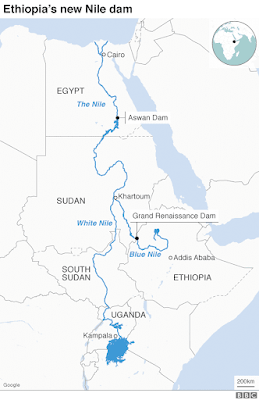Friday, October 02, 2020
Nile blessings in disguise
The Nile is experiencing its highest flooding season in 108 years this year thanks to heavy rainfall on the Ethiopian Highlands, the source of the Atbara, Blue Nile, and Sobat rivers which contribute about 85 per cent of the water of the Nile. The White Nile, which starts in the Great Lakes region of Africa, has a constant flow throughout the year and accounts for only about 15 per cent of Nile water.
This is the third of seven “fat years” in the Nile’s theoretical 20-year cycle. During these years, the river’s flow from its three Ethiopian tributaries can increase by 50 to 100 per cent. In the seven “lean years” that follow them, the flow diminishes by roughly the same amount. In the remaining six years, the water remains at an average level during the flooding season that lasts from June to November.
A UN Food and Agriculture Organisation (FAO) study estimated in 2014 that the Ethiopian Plateau receives some 1,000 billion m3 of rainfall a year, of which about 72 billion m3 flow into the Nile. The remainder flows into the six other rivers that emanate from the Ethiopian Highlands. Heavy flooding seasons can be devastating for Sudanese people living near the Nile, as the rush of water can submerge homes and fields, sweep away livestock, and cause deaths by drowning. The flooding can also place heavy strain on Sudanese dams at Roseires, Sennar, Merowe, and Khashm Al-Girba and on the Aswan High Dam in Egypt.
To avert any potential damage to the structure of the High Dam in the event of overfilling, Egypt’s Ministry of Water Resources and Irrigation has begun to release excess water into the Toshka spillway in the Aswan desert. It has also started diverting quantities of the excess water into irrigation canals in Upper Egypt so that farmers there can use the freshwater to decontaminate the soil from the build-up of the salts and pollutants that have accumulated in it during the 50 years since the High Dam put a stop to the natural flooding season.
As this year’s flooding exceeds the needs of Egypt’s agricultural, domestic, and industrial sectors, the Ministry of Water Resources and Irrigation has decided to use the excess water to “rejuvenate” the Nile itself by allowing a certain amount of it to “sweep” accumulated pollutants northwards and out into the Mediterranean. Particular attention has been given to the Rosetta branch of the Nile, which suffers higher levels of pollution than the Damietta branch because it receives most of the agricultural and waste-water runoff from Upper Egypt.
The Rosetta branch of the Nile has become notorious for fish die-offs during the summer months, when concentrations of pollutants increase as a result of higher temperatures, a phenomenon that has been particularly hard on fish-farmers.
The flow of the Nile in Egypt is assisted by a gradient from 200 metres above sea level in Aswan to zero at the Mediterranean. In addition to this, there is also a slight gradient from east to west in the Delta in the direction of the Rosetta branch and the Beheira governorate, the largest of Egypt’s governorates which stretches from the edge of Giza to Rosetta at the mouth of the Nile on the Mediterranean. As a result of these two gradients, some areas in Beheira and some of the islands in that branch of the Nile will be adversely affected by the cleansing process, despite ministry of irrigation engineers regulating the discharge of water from the High Dam. An estimated 1,200 acres of land in Beheira will be submerged, as opposed to only nine acres on the Damietta branch of the Nile.
As the flovoding season the year is expected to continue until the end of October for the first time in a century, water-resource officials are also thinking about using the excess water to cleanse agricultural land in the Delta from salinisation due to sea-water intrusion and shallow waterlogging (up to less than a metre high) and cumulative salt and pollutant residues generated by the reuse of agricultural drainage water for irrigation.
Large expanses of Egyptian soil have been deprived of the natural cleansing processes of the Nile floods since the High Dam went into operation 50 years ago. Around 46 per cent of the agricultural land in the northern Delta, 37 per cent of the land in the central Delta, and 24 per cent of the land in the southern Delta suffer from heavy soil salinity, meaning that high salinity affects over a third of the agricultural land in the Delta.
This year’s higher-than-average floods make it possible to wash away the excess salts, not to mention the accumulated residues from chemical fertilisers and pesticides. This is precisely what the ministry of water resources and irrigation is doing this year in order to breathe new life into Egyptian soil that had benefited from the fertile silt that the Nile brought into the Delta for thousands of years until the Aswan High Dam was built.
Nader Noureddin -ahram.org.eg
The writer is professor of soil and water sciences at the Faculty of Agriculture at Cairo University.
*A version of this article appears in print in the 1 October, 2020 edition of Al-Ahram Weekly.
Subscribe to:
Post Comments (Atom)

No comments:
Post a Comment
Only News